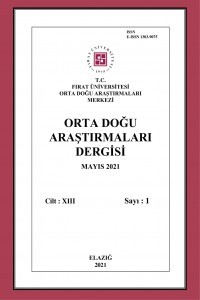Ortaçağlardan XVI. Yüzyıl Sonlarına Tekstil Boyacılığı Genel Özellikleri ve Ticari Nitelikleriyle Boyar Maddeler ve Boyama Tarifleri
Bu makale Ortaçağlardan başlayarak bilhassa tekstil boyacılığının önemli gelişme kaydettiği XV. ve XVI. yüzyıla ilişkin bilgileri içermektedir. Çalışmamızda tekstil boyacılığı Giriş ve Sonuç bölümleri hariç iki ana bölümde ele alınmaktadır. İlk bölümde oldukça geniş bir yelpazede boyar maddelerin nitelikleri ve ticari değerleri üzerinde durulurken ikinci bölümde ağırlıklı olarak XVI. yüzyıla ait boyama teknikleri ayrıntılı bir tarzda sunulmaya çalışılmıştır. Kullanılan kaynaklar itibariyle baktığımızda, ilk bölümde Avrupa ve Ortadoğu coğrafyasında tekstil boyacılığında kullanılan boyar maddelerin hikâyesi, üretim ve kullanım sahaları, daha ziyade tetkik eserlerden istifadeyle ele alınıp değerlendirilmiştir. İkinci bölümün esasını oluşturan boya ve boyama tarifleri XVI. yüzyıl Avrupa’sında oldukça popüler el kitabı niteliğindeki dört eserden; The Sereti per Colori, The Allerley Mackel, The Secretes of the Reverend Maister Alexis of Piemont ve A Profitable Book’dan Türkçe’ye çevirisi yapılmak suretiyle alınmıştır. İslam coğrafyasına ait sınırlı sayıda tarif ise daha ziyade bilimsel nitelikte tetkik eserlerden istifade ile sunulmaya çalışılmıştır. Bu çalışma oldukça geniş bir zaman dilimini ve sahayı kapsadığından geliştirilmeye müsait ve hatta muhtaçtır; ancak yine bu niteliklerinden dolayı önemlidir. Bilhassa Avrupa’da iyi bilinen ancak Türkçe çalışmalarda rastlayamadığımız XVI. yüzyılın bu dört klasik kaynağından tariflerin bu çalışmada yer alması önemini arttırmaktadır.
The Textile Dyeing from the Middle Ages to the End of the Sixteenth Century Dye Matters with General Features and Commercial Qualities and Dying Descriptions
The study explores the knowledge about the textile dyeing in the Middle Ages and with more developing position in fifteenth and sixteenth centuries. This study involves two chapters without Entrance and Conclusion. The first chapter is largely about the qualities and the commercial importance of the pigments and the second chapter is largely about the dyeing techniques in sixteenth century. The first chapter has explanations about the pigment stories: the places where the pigments were grown and used in Europe and the Middle East benefiting from the scholarly studies. The dye and dyeing recipes that formed the bases of the second chapter quoted from the four popular books in the sixteenth century in Europe: The Sereti per Colori, The Allerley Mackel, The Secretes of the Reverend Maister Alexis of Piemont ve A Profitable Book. A few recipes used Islamic Area took from some scholarly studies. This study is possibly developed and even must be developed, because it explores considerably the long period and the wide place, but same time this study is valuable for it’s same qualities. Especially this study is important using the four classic books from 16 century, they have been very known in Europe but not in Turkey
Keywords:
dye, textile, Europe, The Middle East, medieval, modern times,
___
- AKAN, Meral; “Bazı Bitkiler ile Renklendirilmiş İlmelik Yün Halı İpliklerinde Oluşan Mukavemet Farklarının Tespiti Üzerine Bir Araştırma”, Gazi Üniversitesi Endüstriyel Sanatlar Eğitim Fakültesi Dergisi, Sayısı: 21.
- AKGÜNDÜZ, Ahmet; Osmanlı Kanunnameleri ve Hukuki Tahlilleri, c. 2, İstanbul 1990.
- ARMSTRONG, Wayne P.; “Logwood and Brazilwood: Trees That Spawned 2 Nations”, (Modified from: Pacific Horticulture 53: 38-43), Spring 1992, http://waynesword.palomar.edu/ecoph4.htm, 10.06.2008.
- ASLANAPA, Oktay –DURUL, Yusuf; Selçuklu Halıları, Başlangıçtan XVI. yüzyıl Ortalarına Kadar Türk Halı Sanatı, …1973.
- BAKER, Amy; “Common Medieval Pigments”, November 2004, http://www.ischool.utexas.edu/~cochinea/html-paper/a-baker-04- pigments.html, 28.04.2008.
- BAKIR, Abdulhalik; “Ortaçağ İslam Dünyasında Dokuma Sanayisi”, Belleten, c. LXIV, S. 241 (Aralık 2000) Ankara 2001, s. 749-826.
- BAKIR, Abdulhalik; Ortaçağ İslam Dünyasında Tekstil Sanayi Giyim-Kuşam ve Moda, Ankara 2005.
- BECKMANN, John; History of Inventions, Discoveries and Origins, (Translated from German: JOHNSTON, William), London 1846.
- DÖLEN, Emre; Tekstil Tarihi, İstanbul 1992.
- DRUGİNG, Susan C. ; “Dye History from 2600BC to the 20th Century” Washington 1982, www.straw.com/sig/dyehist.html. 27.05.2008.
- GHERMANDI, Elisabetta; “Lasifer Laka-Laccifer Lacca-Cocus LaccaLaksha”, January 2003. http://www.easygrowing.org/documents/EGLasiferLaka.pdf, 05.06.2008.
- HAGE, Rushika; “Cochineal”, http://bell.lib.umn.edu/Products/cochinea.html, 09.06.2008.
- LANING, Chris; “Orchil, the poor person’s purple”, http://www.ravensgard.org/gerekr/Orchil.html, 12.06.2008.
- LEIX, Alfred; “Dyes of the Middle Ages”, Ciba Review 1: Medieval Dyeing Basle, September 1937, http://www.elizabethancostume.net/cibas/ciba1.html#scotland, 03.06.2007.
- LOPEZ, Robert Sabatino; “Silk Industry in the Byzatine Empire”, Speculum, c. 20, no. 1, (Jan. 1945), s. 1-42.
- MATTSON, Anne; “Indigo in the Early Modern World”, http://bell.lib.umn.edu/Products/Indigo.html, 14.08.2008.
- MEZ, Adam; Onuncu Yüzyılda İslam Medeniyeti, İslam’ın Rönesansı, (çev. ŞABAN, Salih) İstanbul 2000.
- MOECKLY, Steven; “The History of the Dye Industry”, Chemistry 297, (15 October 1998), http://www.jergym.hiedu.cz/~canovm/mechanic/pravidl2/gries/g.htm, 03.06.2008.
- MOHR, John Luter; “On the Natural Coloring Matter, Braziling and Its Use in Microscopical Technique”, http://www.smsi.org/publications/mn5001-2.shtml, 15.08.2008.
- OKAYGÜN, Itır –YARAŞ, Füsun; Doğal Boyalarda Yün Boya Uygulaması ve Geleneksel Yöntemler, İstanbul 1983.
- PODHAYNY, Richard M.; “History, Shellfish, Royalty, and the Color Purple”, Jul 1, 2002
- ISSN: 1303-9075
- Başlangıç: 2007
- Yayıncı: Fırat Üniversitesi
Sayıdaki Diğer Makaleler
Ortadoğu’da Su Sorunu Çerçevesinde Dicle ve Fırat Nehirleri Üzerinde Su Anlaşmazlığı
Eskiçağlardan Günümüze Kadar Türkmen Şehri Kerkük
ORTAÇAĞ BOYUNCA MISIR’IN TİCARET POLİTİKASI1 Subhi Labib
A NEW REGIONAL ORGANIZATION MODEL SOUTHWEST ASIA UNION
Asrısaadet’in Dinamik Düşünce Hayatından Uzaklaşma Ya Da Yeryüzü Cennetinden Çıkış
Harput’ta Amerikan Misyonuna Karşı Ermenilerin Tepkisini Gösteren 1895 Tarihli Bir Belge
